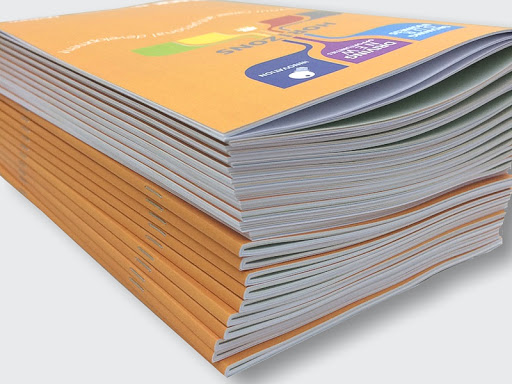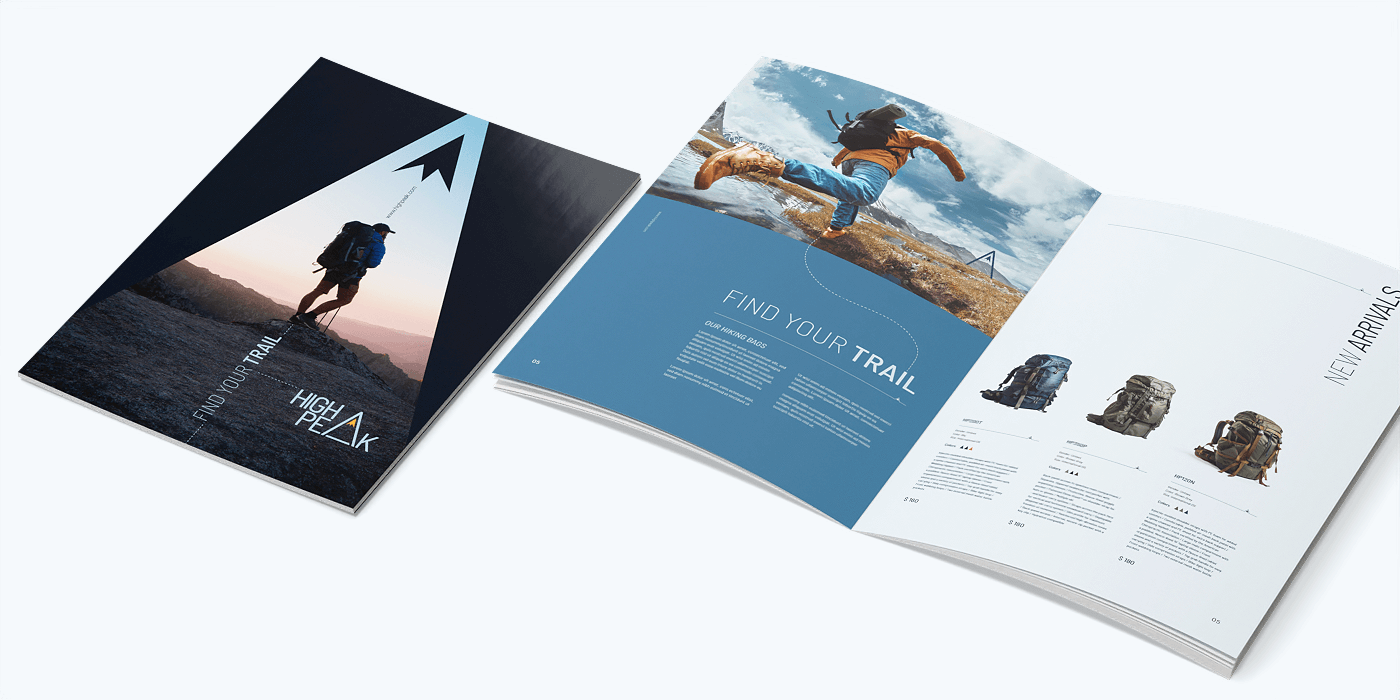A Step-by-Step Guide to Planning a Custom Booklet Printing Campaign
A Step-by-Step Guide to Planning a Custom Booklet Printing Campaign
Blog Article
The Crucial Guide to Understanding Pamphlet Printing Options and Techniques
The process of booklet printing entails numerous considerations that can substantially impact the last item. From choosing the proper format and dimension to understanding the subtleties of binding methods, each selection plays a vital function. Additionally, variables such as paper stock and printing strategies more affect the performance of the pamphlet. As one navigates these options, it ends up being imperative to realize how they adjoin and what that implies for the overall result.
Understanding Pamphlet Sizes and styles
When thinking about brochure printing, understanding the various layouts and dimensions available is important for attaining the wanted discussion. Brochures can be generated in countless styles, consisting of saddle-stitched, spiral-bound, and perfect-bound, each offering distinctive benefits. Usual dimensions range from typical letter (8.5 x 11 inches) to smaller choices like A5 (5.8 x 8.3 inches), permitting versatility based upon content and target audience.Selecting the ideal size can influence both the design and viewers interaction. Bigger dimensions may suit aesthetically driven content, while smaller sized styles might be more portable and user-friendly. Additionally, the variety of pages impacts the selection of binding approach, as thicker booklets might require stronger bindings. Eventually, comprehending these aspects enables an extra tailored strategy, guaranteeing that the end product straightens with the designated message and visual, enhancing the overall performance of the interaction.
Selecting the Right Paper Stock

Binding Methods: Choices and Factors To Consider
When it comes to binding approaches for brochures, a number of choices are readily available, each with distinctive benefits. Saddle stitch binding supplies an affordable option for thinner brochures, while excellent binding strategies supply an even more refined search for thicker magazines. Wire-O binding sticks out for its sturdiness and ease of usage, making it excellent for files that need versatility.
Saddle Stitch Binding
Saddle stitch binding provides a practical and cost-efficient service for assembling booklets, making it a popular choice amongst authors and businesses. This binding technique entails folding sheets of paper in half and stapling them along the fold line, developing a neat and well organized look. Typically appropriate for pamphlets with a reduced page matter, saddle stitching is optimal for publications, brochures, and instructional materials. The simplicity of this method permits quick manufacturing and is often preferred for marketing things or brief runs. However, it is vital to note that saddle stitch binding might not appropriate for thicker brochures, as the back may not hold up under enhanced weight. Overall, it continues to be a trustworthy alternative for several printing tasks.
Perfect Binding Strategies
Perfect binding is an extensively made use of technique that provides a sleek and professional finish to publications and pamphlets. This technique involves gluing the pages with each other at the back utilizing a solid adhesive, enabling a clean edge and the capacity to hold a bigger number of web pages compared to saddle sewing. Perfect binding is particularly suitable for thicker brochures, such as magazines and annual records, where a sturdy, flat spinal column is desired. In addition, it supplies the choice for a published cover that can be designed to boost aesthetic charm. Considerations such as page matter, paper weight, and the planned use of the booklet must be taken into account, as they can impact sturdiness and overall quality.
Wire-O Binding Choices
Wire-O binding, understood for its durability and flexibility, uses an excellent choice for pamphlets that call for very easy page turning and an expert look. This binding method uses a series of steel loops that hold pages firmly, allowing them to exist level when open. It is particularly appropriate for presentations, catalogs, and manuals due to its robust nature. Wire-O binding is readily available in various shades and sizes, suiting different page matters and thicknesses. In addition, it permits the incorporation of covers and tabs, improving the pamphlet's total aesthetic. Factors to consider for Wire-O binding include the selection of wire color, the size of the loopholes, and the degree of customization preferred, every one of which can greatly influence the end product's appearance and performance.
Digital vs. Offset Printing: Which Is Best for You?
When picking a printing approach for pamphlets, recognizing the distinctions between electronic and counter printing is important. Digital printing uses modern innovation to produce top quality prints swiftly and economically, making it suitable for brief runs or jobs calling for quick turnaround times. It enables modification, providing the capability to publish on-demand with very little waste.In contrast, balance out printing is a typical approach that excels in generating large amounts with consistent quality. It includes transferring ink from a plate to a rubber blanket, then to the paper, which causes accurate details and lively shades. Nonetheless, offset printing usually calls for longer arrangement times and is more economical for larger volumes.Ultimately, the selection between electronic and offset printing depends upon task requirements, spending plan, and desired quantity. For little, time-sensitive tasks, digital may be the ideal selection, while balanced out may be more suitable for larger, high-grade manufacturings.

Designing Your Pamphlet: Tips and Ideal Practices
When making a pamphlet, cautious interest to design, font style selection, and shade usage can greatly enhance its efficiency. A well-structured design overviews the viewers's eye, while ideal typefaces ensure readability and communicate the wanted tone. In addition, efficient use color can stimulate emotions and emphasize essential info, making the general layout a lot more impactful.
Picking the Right Design
Just how can one properly choose the right format for a pamphlet? Initially, it is necessary to evaluate the brochure's purpose and target market. A clean, organized layout boosts readability and involvement. Utilizing a grid system can aid in aligning components continually, creating an expert look. Furthermore, including visual hierarchy via varying dimensions and placements of pictures and message can lead the visitor's eye and stress crucial info. It is additionally vital to leave sufficient white area, which avoids congestion and permits far better emphasis. Testing different layouts through mock-ups can offer understanding right into just how the design executes in real-world circumstances, guaranteeing that the final item meets both functional and aesthetic requirements. Useful Choosing Ideal Typefaces
An appropriate font Look At This style can significantly enhance the general design of a brochure, matching the layout and strengthening the material's message. The option of font styles should think about readability, specifically for body message, as it guarantees the information is easily accessible to all visitors. Sans-serif typefaces are typically favored for digital layouts, while serif typefaces can offer a conventional feeling in printed YOURURL.com products. It's advisable to limit font choices to 2 or 3 to maintain visual coherence. Furthermore, font style dimension plays an important duty; headings need to be not overwhelming yet distinct, while body message must fit for analysis. When choosing fonts, alignment with the booklet's motif and target market is necessary for efficient interaction and aesthetic appeal.
Reliable Use Color
Shade functions as a powerful device in brochure layout, leading and shaping assumptions visitor feelings. It can evoke sensations of excitement, depend on, or calmness, depending upon the tones selected. Developers ought to take into consideration color concept concepts, guaranteeing that the picked palette lines up with the pamphlet's message and target audience. Using cozy colors like red and orange can develop seriousness, while cooler tones like environment-friendly and blue foster tranquility.Additionally, comparison plays a crucial function; complementary shades can improve readability and aesthetic allure. Consistency in shade use across pages additionally strengthens brand identification and communication. Eventually, effective color application not just records attention however additionally strengthens the booklet's objective, making it an important aspect of effective layout.
Completing Touches: Coatings and Special Effects
While many take into consideration the content and layout of a booklet one of the most important elements, the finishing touches, such as layers and unique effects, play a necessary role in improving its total allure. Coatings can supply protection and toughness, guaranteeing that the booklet holds up against deterioration. Matte coatings supply a sophisticated, non-reflective surface area, while glossy finishings can make shades appear even more lively and attractive. Unique effects, like embossing or foil marking, include a tactile measurement that can create a memorable perception. These techniques can highlight details areas, accentuating crucial information or producing aesthetic interest. In addition, UV finishing can supply a high-shine coating that raises the total look.Together, these ending up touches not more only improve the brochure's visual however also connect professionalism and trust and focus to detail, ultimately leaving a long lasting influence on the visitor.
Price Considerations for Pamphlet Printing
Understanding the various price factors to consider for pamphlet printing is crucial for organizations and companies aiming to maximize their budget plans. Key variables influencing prices include the selection of ink, paper, and binding methods. Better products, such as superior paper or specialized inks, usually enhance the general expenditure. Additionally, the dimension and page count of the booklet play a significant function; bigger booklets need even more sources and time to produce.Another important consideration is the printing method, whether digital or balanced out, as each has its very own prices framework and viability for various amounts. Businesses need to also consider style expenses, which can vary based upon intricacy and making use of specialist services. Eventually, delivery and handling fees can include in the total, especially for huge orders. By assessing these elements, organizations can make educated choices that line up with their economic capabilities while attaining the preferred high quality in their printed materials.
Often Asked Questions
What Are the Ecological Effects of Brochure Printing?
The environmental impacts of brochure printing consist of logging from paper manufacturing, carbon discharges from transport, and waste generation from disposed of products - Booklet Printing. Sustainable methods, such as utilizing recycled paper and environment-friendly inks, can mitigate these results
Exactly How Can I Make Certain Color Precision in My Pamphlet?
To ensure color accuracy in a booklet, one must use calibrated displays, utilize specialist shade accounts, carry out examination prints, and pick top notch printing solutions that supply shade matching and proofing choices for best outcomes.
What Is the Normal Turn-around Time for Pamphlet Printing?
The typical turn-around time for booklet printing varies depending on the complexity and amount - Booklet Printing. Normally, it varies from a couple of days to 2 weeks, influenced by elements such as printing techniques and completing demands
Exist Minimum Order Quantities for Brochure Printing?

Can I Print Booklets in Numerous Languages?
Printing booklets in multiple languages is possible. Many printing solutions supply alternatives for multilingual or multilingual layouts, permitting effective interaction. Careful preparation assurances that develop elements accommodate different languages without endangering readability or aesthetics. Additionally, elements such as paper supply and printing techniques additional affect the effectiveness of the brochure. When thinking about booklet printing, understanding the various layouts and dimensions readily available is crucial for attaining the desired discussion. When picking a printing technique for pamphlets, recognizing the distinctions between digital and balance out printing is necessary. In addition, the size and page matter of the brochure play a considerable duty; larger pamphlets need more resources and time to produce.Another vital consideration is the printing technique, whether electronic or offset, as each has its very own rates structure and suitability for different amounts. The environmental impacts of booklet printing consist of logging from paper production, carbon emissions from transport, and waste generation from discarded materials.
Report this page